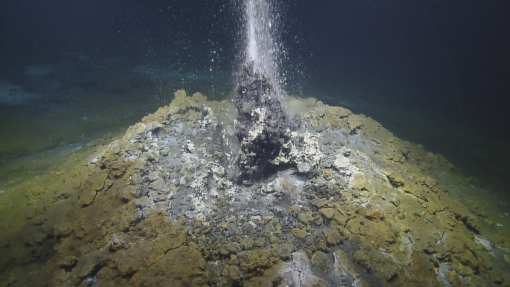Geology
The deep ocean floor is anything but boring. Some of the tallest mountains on Earth are underwater, making up a deep sea mountain chain called a mid-ocean ridge. Others dot the seafloor in the form of solitary seamounts. There are over 100,000 of these submerged mountains globally, each measuring over 1,000 meters tall (3,200 feet). While many are millions of years old, some are active volcanoes that are still taking shape today. Exploring volcanoes -- young and old -- gives scientists insight into how our planet continues to form and change over time.
While much of the seafloor is relatively calm and stable, the areas where oceanic and continental plates meet underwater are incredibly dynamic. The same forces that create and destroy sections of the Earth's crust produce volcanoes, hydrothermal vents, rare earth deposits, and more. Known as plate boundaries, these regions commonly have high-temperature vents that are a conduit for water from beneath the seafloor. Deposits of sulfides, metals, and carbonates can build towering black or white smoker chimneys and spires. Other deep-sea phenomena occur at the edges of our continents where plate boundaries are characterized by rocky or sediment-filled canyons, methane seeps, and faults. These areas can be prone to seismic events, which can lead to natural hazards such as underwater landslides and tsunamis.

The geology of the seafloor is foundational to life on Earth. Rocks, large and small, are particularly important for hosting deep-sea or cold-water coral and sponge communities, which in turn often provide nooks for fish nursery grounds and homes for other benthic organisms. Chemosynthetic communities at seafloor vents host life in the deep, dark ocean, far away from nutrients found on land or derived from the sun. At some cold seep sites, highly saline brine pools are toxic for most organisms, but some organisms have adapted to life in this extreme habitat by processing seep gases and chemicals into energy.

Precious geological resources can also be found in the deepest parts of the ocean. Seafloor hydrothermal vents discharge superheated fluids from Earth’s interior, carrying metals that have the potential to leave large deposits of rare minerals and metals on the seafloor. Polymetallic sulfide nodules contain high concentrations of nickel, cobalt, copper, and manganese and are found on abyssal sediments, such as within the Clarion Clipperton Fracture Zone, in the Pacific Ocean. Deep-sea rocks and seamounts are coated in manganese as well, hiding the interior structure and type of rock. Deep-sea precious metals and minerals are limited but necessary resources for computing, automotive, and electronics industries that are becoming increasingly scarce on land.

Understanding seafloor structure is made possible through seafloor mapping with the multibeam sonar and sub-bottom profiler systems, which is mounted on the hull of Nautilus. These sensors provide important insight into the height, location, shape, and reflective nature of seafloor features. Scientists use that information to determine the best locations for ROV dives that will provide new understanding of earth and ocean processes. Once ROVs are on the seafloor, explorers are on the lookout for in situ representative rock samples and unique locations to take sediment core samples -- both of which help researchers better understand the composition of the seafloor as well as its formation and age. The geological samples we collect are housed at the Marine Geological Samples Lab at the University of Rhode Island’s Graduate School of Oceanography. Nautilus hosts scientists studying all facets of marine geology and makes samples available by request to researchers.
Expeditions
Get a sneak peek of where we're headed next or revisit the discoveries of our past expeditions.
Gallery
Explore the deep ocean and some of our favorite moments through our rich media gallery of photos and videos from all of our expeditions.
Classroom Resources
OET hosts a suite of free educational materials for use in classrooms, at home, or in the community.
